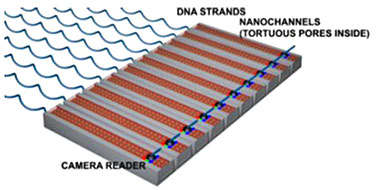Recent News
CHTM Joins NSF's NQVL Pilot Projects
August 9, 2024
OSE PHD, Dr. Xuefeng Li - Wins The Outstanding Interdisciplinary Graduate Programs Award
May 10, 2024
Dr. Ali Rastegari - 2024 OSE Best Dissertation Award Winner
May 10, 2024
2024 OSE Spring and Summer Graduates
May 10, 2024
News Archives
Nanopore technology developed at CHTM will aim to complete DNA sequencing of human genome in minutes
March 1, 2017 - Republished from STC.UNM newsletter, Spring 2017

Steven R. J. Brueck
A young company developing technology created at the University of New Mexico (UNM) is on a mission to disrupt the landscape of DNA sequencing. Armonica Technologies, LLC, is developing a DNA sequencing platform that will sequence a complete human genome in minutes. The company’s goal is to make the technology the gold standard for DNA sequencing for precision medicine research applications. Armonica has optioned a portfolio of patented and patent pending technologies from STC.UNM. The technology is called optical nanopore sequencing and uses nanochannels to deliver single DNA molecules through nanopores. The nanopores slow down DNA translocation enough to produce massively parallel, single-base resolution using optical techniques.
Nanopores are very small holes with an internal diameter of 1 nanometer (one billionth of a meter). Proteins can act as biological nanopores or they can be created by etching holes in silicon or graphene.
Nanopore sequencing works in this way: When a nanopore is immersed in conducting fluid, voltage can be applied to produce an electric current. The current is sensitive to the size and shape of the nanopore so that if a DNA strand passes through or near the nanopore, the amount of current changes. The change in the current as the DNA molecule passes through the nanopore represents a reading of the DNA sequence.

“There is an unmet need in the fast-growing DNA sequencing market,” says Armonica President & CEO Scott Goldman. “Today’s standard genome sequencing approach requires extensive library preparation and creates a massive computational and bioinformatics problem related to reassembling the data set. Armonica will resolve these problems by introducing a sequencing instrument that will not require library preparation and will generate reads of up to 50,000 bases, combined with a parallelism of 1 million. This approach will net 50 billion bases—more than sufficient to sequence the entire human genome in minutes.”

Alexander Neumann

Yuliya Kuznetsova
The innovative nanopore technology was developed by Distinguished Professor Emeritus Steve Brueck, Research Assistant Professor Yuliya Kuznetsova, and Postdoctoral Fellow Alexander Neumann from UNM’s Center for High Technology Materials and Professor Jeremy Edwards from UNM's Department of Chemistry & Chemical Biology in collaboration with Redondo Optics CEO Edgar Mendoza.
Dr. Brueck explained the technology’s innovations. “Nanopore sequencing analyzes long DNA strings, with long reads that provide more accurate identification of genome variations. It is an approach, therefore, that leads to a more thorough, faster, and accurate genomic analysis, allowing researchers to substantially improve the ability to make new discoveries. One of the challenges of nanopore sequencing is to improve the resolution to be able to detect single nucleotides (bases).

“We believe our nanochannel technology will disrupt the industry because it produces very long reads for higher accuracy, very high parallelism using optical techniques, and high throughput rates for greater processing speed. It will be an affordable tool for researchers.”
STC CEO Lisa Kuuttila added: “This technology portfolio represents a leap in genomic sequencing technology that could be a huge benefit for the DNA sequencing industry, which is experiencing explosive growth. The company’s research and development are currently being done at UNM’s Center for High Technology Materials (CHTM), a research center with a global reputation for inventing disruptive nanoscale technologies and providing outstanding scientific expertise and technical support. We are very excited about the technology’s potential and believe in the company’s vision.”
The inventors have successfully demonstrated the viability of the technology and have received a National Institutes of Health Small Business Innovation Research (SBIR) grant to advance development of sequencing instruments for genomic, research, and medical facilities.
Source:
Start-Up Armonica Technologies Developing Innovative DNA Nanopore Sequencing Technology, page 3, Rainforest in the Desert, STC.UNM newsletter, Spring 2017
Related:
• Pushing the boundaries of DNA sequencing, UNM Newsroom, March 3, 2017
• STC.UNM Spotlight, May 1, 2016: Yuliya V. Kuznetsova, Ph.D.


